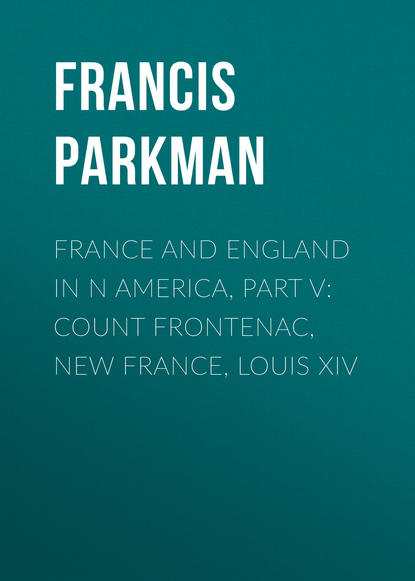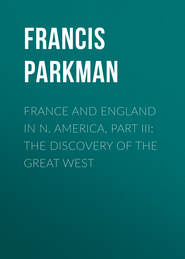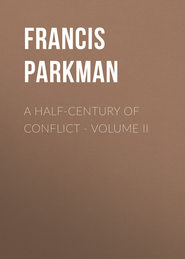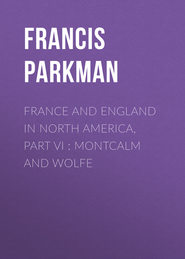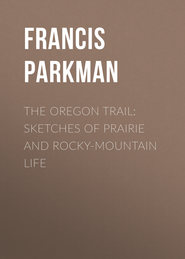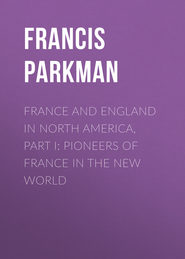По всем вопросам обращайтесь на: info@litportal.ru
(©) 2003-2024.
✖
France and England in N America, Part V: Count Frontenac, New France, Louis XIV
Настройки чтения
Размер шрифта
Высота строк
Поля
The account of this council is given, with condensation and the omission of parts not essential, from Colden (105-112, ed. 1747). It will serve as an example of the Iroquois method of conducting political business, the habitual regularity and decorum of which has drawn from several contemporary French writers the remark that in such matters the five tribes were savages only in name. The reply to Frontenac is also given by Monseignat (N. Y. Col. Docs., IX. 465), and, after him, by La Potherie. Compare Le Clercq, Établissement de la Foy, II. 403. Ourehaoué is the Tawerahet of Colden.
228
Message of Ourehaoué, in N. Y. Col. Docs., III. 735; Instructions to Chevalier d'Eau, Ibid., 733; Chevalier d'Aux au Ministre, 15 Mai, 1693. The chevalier's name is also written d'O, He himself wrote it as in the text.
229
Carheil à Frontenac, 1690. Frontenac did not receive this letter till September, and acted on the information previously sent him. Charlevoix's version of the letter does not conform with the original.
230
Parole (de M. de Frontenac) qui doit être dite à l'Outaouais pour le dissuader de l'Alliance qu'il vent faire avec l'Iroquois et l'Anglois. The message is long. Only the principal points are given above.
231
"Le Père Missionnaire des Hurons, prévoyant que cette affaire auroit peut-être une suite qui pourrait être préjudiciable aux soins qu'il prenoit de leur instruction, demanda qu'il lui fut permis d'aller à leur village pour les obliger de trouver quelque moyen qui fut capable d'appaiser le ressentiment des François. Il leur dit que ceux-ci vouloient absolument que l'on mit l'Iroquois à la chaudière, et que si on ne le faisoit, on devoit venir le leur enlever." La Potherie, II. 237 (1722). By the "result prejudicial to his cares for their instruction" he seems to mean their possible transfer from French to English influences. The expression mettre à la chaudière, though derived from cannibal practices, is often used figuratively for torturing and killing. The missionary in question was either Carheil or another Jesuit, who must have acted with his sanction.
232
Relation de Monseignat, 1689-90. There is a translation of this valuable paper in N. Y. Col. Docs., IX. 462. The party, according to three of their number, consisted at first of 160 French and 140 Christian Indians, but was reduced by sickness and desertion to 250 in all. Examination of three French prisoners taken by y
. Maquas (Mohawks), and brought to Skinnectady, who were examined by Peter Schuyler, Mayor of Albany, Domine Godevridus Dellius, and some of y
. Gentle
. that went from Albany a purpose.
233
Colden, 114 (ed. 1747).
234
"The women bigg with Childe rip'd up, and the Children alive throwne into the flames, and their heads dashed to pieces against the Doors and windows." Schuyler to the Council of Connecticut, 15 Feb., 1690. Similar statements are made by Leisler. See Doc. Hist. N. Y., I. 307, 310.
235
List of y
. People kild and destroyed by y
. French of Canida and there Indians at Skinnechtady, in Doc. Hist. N. Y., I. 304.
236
Many of the authorities on the burning of Schenectady will be found in the Documentary History of New York, I. 297-312. One of the most important is a portion of the long letter of M. de Monseignat, comptroller-general of the marine in Canada, to a lady of rank, said to be Madame de Maintenon. Others are contemporary documents preserved at Albany, including, among others, the lists of killed and captured, letters of Leisler to the governor of Maryland, the governor of Massachusetts, the governor of Barbadoes, and the Bishop of Salisbury; of Robert Livingston to Sir Edmund Andros and to Captain Nicholson; and of Mr. Van Cortlandt to Sir Edmund Andros. One of the best contemporary authorities is a letter of Schuyler and his colleagues to the governor and council of Massachusetts, 15 February, 1690, preserved in the Massachusetts archives, and printed in the third volume of Mr. Whitmore's Andros Tracts. La Potherie, Charlevoix, Colden, Smith, and many others, give accounts at second-hand.
Johannes Sander, or Alexander, Glen, was the son of a Scotchman of good family. He was usually known as Captain Sander. The French wrote the name Cendre, which became transformed into Condre, and then into Coudre. In the old family Bible of the Glens, still preserved at the place named by them Scotia, near Schenectady, is an entry in Dutch recording the "murders" committed by the French, and the exemption accorded to Alexander Glen on account of services rendered by him and his family to French prisoners. See Proceedings of N. Y. Hist. Soc., 1846, 118.
The French called Schenectady Corlaer or Corlar, from Van Curler, its founder. Its treatment at their hands was ill deserved, as its inhabitants, and notably Van Curler himself, had from the earliest times been the protectors of French captives among the Mohawks. Leisler says that only one-sixth of the inhabitants escaped unhurt.
237
Schuyler, Wessell, and Van Rensselaer to the Governor and Council of Massachusetts, 15 Feb., 1690, in Andros Tracts, III. 114.
238
Propositions made by the Sachems of y
. Maquase (Mohawk) Castles to y
. Mayor, Aldermen, and Commonality of y
. Citty of Albany, y
. 25 day of february, 1690, in Doc. Hist. N. Y., II. 164-169.
239
The Abenaki migration to Canada began as early as the autumn of 1675 (Relation, 1676-77). On the mission of St. Francis on the Chaudière, see Bigot, Relation, 1684; Ibid., 1685. It was afterwards removed to the river St. Francis.
240
Hutchinson, Hist. Mass., I. 326. Compare N. Y. Col. Docs., IV. 282, 476.
241
"En partant de Canada, j'ay laissé une très grande disposition à attirer au Christianisme la plus grande partie des sauvages Abenakis qui abitent les bois du voisinage de Baston. Pour cela il faut les attirer à la mission nouvellement établie près Québec sous le nom de S. François de Sale. Je l'ai vue en peu de temps au nombre de six cents âmes venues du voisinage de Baston. Je l'ay laissée en estat d'augmenter beaucoup si elle est protegée; j'y ai fait quelque dépense qui n'est pas inutile. La bonne intelligence que j'ai eue avec ces sauvages par les soins des Jésuites, et surtout des deux pères Bigot frères a fait le succès de toutes les attaques qu'ils ont faites sur les Anglois cet esté, aux quels ils ont enlevé 16 forts, outre celuy de Pemcuit (Pemaquid) ou il y avoit 20 pièces de canon, et leur ont tué plus de 200 hommes." Denonville au Ministre, Jan., 1690.
It is to be observed that this Indian outbreak began in the summer of 1688, when there was peace between France and England. News of the declaration of war did not reach Canada till July, 1689. (Belmont.) Dover and other places were attacked in June of the same year.
The intendant Champigny says that most of the Indians who attacked the English were from the mission villages near Quebec. Champigny au Ministre, 16 Nov., 1689. He says also that he supplied them with gunpowder for the war.
The "forts" taken by the Indians on the Kennebec at this time were nothing but houses protected by palisades. They were taken by treachery and surprise. Lettre du Père Thury, 1689. Thury says that 142 men, women, and children were killed.
242
Andros, Account of Forces in Maine, in 3 Mass. Hist. Coll., I. 85. Compare Andros Tracts, I. 177; Ibid., II. 181, 193, 207, 213, 217; Ibid., III. 232; Report of Andros in N. Y. Col. Docs., III. 722. The order for the reduction of the garrisons and the return of the suspected officers was passed at the first session of the council of safety, 20 April. The agents of Massachusetts at London endeavored to justify it. See Andros Tracts, III. 34. The only regular troops in New England were two companies brought by Andros. Most of them were kept at Boston, though a few men and officers were sent to the eastern garrison. These regulars were regarded with great jealousy, and denounced as "a crew that began to teach New England to Drab, Drink, Blaspheme, Curse, and Damm." Ibid., II. 59.
In their hatred of Andros, many of the people of New England held the groundless and foolish belief that he was in secret collusion with the French and Indians. Their most dangerous domestic enemies were some of their own traders, who covertly sold arms and ammunition to the Indians.
243
Andros in 3 Mass. Hist. Coll., I. 85. The original commanding officer, Brockholes, was reputed a "papist." Hence his removal. Andros Tracts, III. 35. Andros says that but eighteen men were left in the fort. A list of them in the archives of Massachusetts, certified by Weems himself, shows that there were thirty. Doubt is thrown on this certificate by the fact that the object of it was to obtain a grant of money in return for advances of pay made by Weems to his soldiers. Weems was a regular officer. A number of letters from him, showing his condition before the attack, will be found in Johnston, History of Bristol, Bremen, and Pemaquid.
244
Captivity of John Gyles. Gyles was one of the inhabitants.





